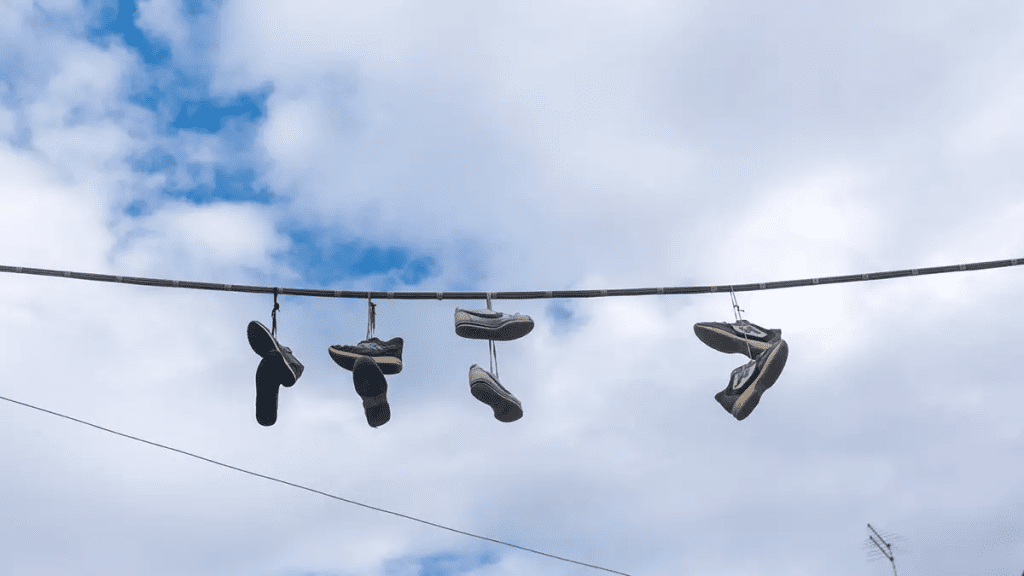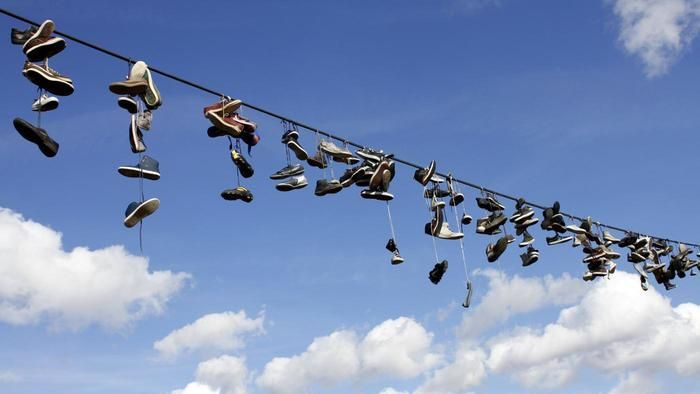We’ve all seen it—pairs of worn-out sneakers dangling from overhead power lines, swaying in the breeze like some sort of modern-day ritual. It’s a curious sight that’s as common in bustling cities as it is in quiet suburbs. But have you ever stopped to ask, Why are those shoes up there? This quirky phenomenon has been around for decades, and while it might seem random, the reasons behind it are far more layered than you’d expect.
From historical roots to cultural symbolism and even safety concerns, hanging shoes on power lines tells a surprisingly rich story about society, identity, and urban folklore. Let’s dive in.
Where It All Began: The Murky Origins of a Strange Tradition

The truth is, there’s no single origin for this custom. Instead, it seems to have evolved through a patchwork of local practices and myths. Some say it started with soldiers tossing their boots over power lines to celebrate the end of their service—a symbolic goodbye to a chapter of hardship and camaraderie. Others claim it was born in the gritty alleys of urban neighborhoods as gang members marked their territory.
The origin depends on where you are, who you ask, and what stories have been passed down in that particular zip code. That’s what makes it so fascinating—it’s part ritual, part urban myth.
Shoes as Symbols: The Hidden Meanings in the Sky
Culturally speaking, hanging shoes can mean a lot of things. In some communities, it’s an act of rebellion—like carving your name into a desk, but bolder. In others, it’s a memorial. A tribute. A moment frozen in time.
Think about it: shoes carry us through life’s journeys. They’re deeply personal. Tossing them up high might be someone’s way of letting go, honoring a transition, or even making a statement that words can’t.
It’s art for some, an unspoken message for others. A rite of passage. A silent scream. Or maybe, just maybe, it’s a celebration of moving forward.
Video : SHOES HANGING ON POWER LINES
The Theories: Harmless Prank or Hidden Message?
Here’s where things get really interesting. People have all sorts of theories about why shoes end up on wires. Let’s break down the most popular ones:
- Teenager tradition: For many, it’s a coming-of-age ritual—graduation, a breakup, a wild summer night. Shoes on a wire? Proof that you lived it.
- Gang markings: There’s long been speculation that shoe-laden wires signal gang territory. While some gangs may use visual cues like graffiti or symbols, the shoe theory remains largely anecdotal and varies widely from place to place.
- Drug house signal: One of the most persistent myths is that shoes indicate nearby drug activity. Again, little to no evidence supports this idea, but the belief continues to circulate.
- Tributes to the deceased: Some see the hanging shoes as a kind of memorial—a way to honor someone who passed away, especially in tight-knit neighborhoods.
So, is it a prank? A message? A tribute? Sometimes, it’s all of the above. And sometimes… it’s just two bored kids with a pair of sneakers and good aim.
Urban Legends: The Myths That Refuse to Die
Like all great urban mysteries, this one has inspired countless legends. In one version, the shoes belong to someone who was killed, a haunting reminder of violence. In another, they’re the shoes of someone who made it out—escaped poverty, abuse, or addiction—and tossed them as a symbol of freedom.
Every city seems to have its own story. That’s what gives this practice its almost mythical status. It’s like a visual rumor, passed from block to block without a clear source.
When Shoes Become a Safety Hazard

As poetic or playful as it may seem, hanging shoes on power lines isn’t exactly harmless. Those lines are part of a city’s electrical infrastructure, and throwing shoes (especially if they’re wet or metal-tipped) can cause real problems.
We’re talking:
- Power outages
- Electrical sparks
- Damage to cables
- Risk to utility workers
Utility crews often have to step in, using specialized tools to remove them. That means time, money, and manpower spent cleaning up a prank—or what someone thought was harmless fun.
Real-Life Cases: When Cities Step In
In places like Los Angeles, Chicago, and parts of New York, shoe-covered power lines became such a common issue that city workers were assigned to routinely remove them. Some neighborhoods even organized community cleanups. Others took a more creative approach—turning the shoes into art installations instead of treating them as trash.
Each case tells a different story. In some towns, it’s a fight for aesthetics and safety. In others, it’s a battle over symbolism, gentrification, and expression.
How Communities React: Harmless or Harmful?
Public opinion is split. Some folks see it as harmless rebellion—a nostalgic reminder of teenage years and mischief. Others view it as an eyesore or a symbol of neglect and lawlessness.
In more conservative areas, local groups may push for laws or penalties against the act. Meanwhile, in creative circles, it’s celebrated as public art—raw, unfiltered, and deeply human.
At its core, the reaction often reflects how a community views expression versus order. One person’s vandalism is another’s voice.
The Legal Side: Is It Against the Law?
Video : Meaning of Shoes over Powerline
Yes, in many places, hanging shoes on power lines can be considered illegal. It often falls under vandalism or destruction of public property, and those caught doing it could face fines or even arrest.
Authorities take the issue seriously, especially when public safety is involved. Utility companies and law enforcement sometimes team up to track down repeat offenders and launch awareness campaigns to educate youth.
Fighting the Trend: Prevention and Outreach
So, what’s being done to stop it? A lot of cities are tackling the issue through community outreach, not just punishment. Programs aimed at teens focus on giving them creative outlets for expression—art programs, sports, volunteer projects—so they don’t feel the need to toss shoes in the first place.
Education is key. If people know the risks (and costs), many will think twice before flinging their old Nikes sky-high.
Conclusion: More Than Just Shoes on a Wire
At first glance, it might look like just a pair of sneakers hanging from a power line. But look closer, and you’ll see stories. History. Culture. A strange form of communication written across city skylines.
Whether it’s a rite of passage, a whispered message, or a moment of spontaneous rebellion, the act of hanging shoes on power lines continues to spark conversation and curiosity. And maybe that’s the point.
Because in the end, what hangs in the sky tells us just as much about what’s happening on the ground.


